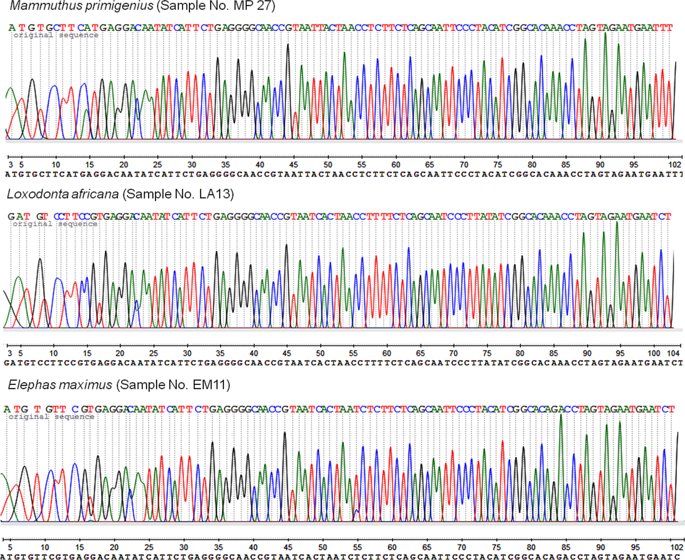Our official English website, www.x-mol.net, welcomes your feedback! (Note: you will need to create a separate account there.)
Distinguishing extant elephants ivory from mammoth ivory using a short sequence of cytochrome b gene.
Scientific Reports ( IF 3.8 ) Pub Date : 2019-12-11 , DOI: 10.1038/s41598-019-55094-x Jacob Njaramba Ngatia 1 , Tian Ming Lan 2, 3, 4 , Yue Ma 1, 5 , Thi Dao Dinh 1 , Zhen Wang 1, 5 , Thomas D Dahmer 6 , Yan Chun Xu 1, 5, 7
Scientific Reports ( IF 3.8 ) Pub Date : 2019-12-11 , DOI: 10.1038/s41598-019-55094-x Jacob Njaramba Ngatia 1 , Tian Ming Lan 2, 3, 4 , Yue Ma 1, 5 , Thi Dao Dinh 1 , Zhen Wang 1, 5 , Thomas D Dahmer 6 , Yan Chun Xu 1, 5, 7
Affiliation

|
Trade in ivory from extant elephant species namely Asian elephant (Elephas maximus), African savanna elephant (Loxodonta africana) and African forest elephant (Loxodonta cyclotis) is regulated internationally, while the trade in ivory from extinct species of Elephantidae, including woolly mammoth, is unregulated. This distinction creates opportunity for laundering and trading elephant ivory as mammoth ivory. The existing morphological and molecular genetics methods do not reliably distinguish the source of ivory items that lack clear identification characteristics or for which the quality of extracted DNA cannot support amplification of large gene fragments. We present a PCR-sequencing method based on 116 bp target sequence of the cytochrome b gene to specifically amplify elephantid DNA while simultaneously excluding non-elephantid species and ivory substitutes, and while avoiding contamination by human DNA. The partial Cytochrome b gene sequence enabled accurate association of ivory samples with their species of origin for all three extant elephants and from mammoth. The detection limit of the PCR system was as low as 10 copy numbers of target DNA. The amplification and sequencing success reached 96.7% for woolly mammoth ivory and 100% for African savanna elephant and African forest elephant ivory. This is the first validated method for distinguishing elephant from mammoth ivory and it provides forensic support for investigation of ivory laundering cases.
中文翻译:

使用短序列的细胞色素b基因将现存的象牙与猛ma象牙区分开。
现有象种的象牙贸易受国际管制,亚洲象(Elephas maximus),非洲大草原象(Loxodonta africana)和非洲森林象(Loxodontacyclotis)的象牙贸易受到国际管制,而象鼻虫(Elephantidae)灭绝物种的象牙贸易则包括羊毛象。不受管制。这种区别为象牙象象象象象的洗涤和交易创造了机会。现有的形态学和分子遗传学方法不能可靠地区分缺少清晰识别特征或提取的DNA的质量不能支持大基因片段扩增的象牙制品的来源。我们提出了一种基于细胞色素b基因116 bp目标序列的PCR测序方法,可特异性扩增大象类DNA,同时排除非大象类和象牙替代品,同时避免被人类DNA污染。Cytochrome b基因的部分序列使象牙样品与所有三只现存大象和猛ma象的起源物种能够准确关联。PCR系统的检测限低至目标DNA的10个拷贝数。羊毛猛ma象牙的扩增和测序成功率达到96.7%,非洲大草原象和非洲森林象牙的成功率达到100%。这是第一种经过验证的区分大象和猛mm象牙的方法,为调查象牙洗钱案件提供了法证支持。同时避免人类DNA污染。Cytochrome b基因的部分序列使象牙样品与所有三只现存大象和猛ma象的起源物种能够准确关联。PCR系统的检测限低至目标DNA的10个拷贝数。羊毛猛ma象牙的扩增和测序成功率达到96.7%,非洲大草原象和非洲森林象牙的成功率达到100%。这是第一种经过验证的区分大象和猛mm象牙的方法,为调查象牙洗钱案件提供了法证支持。同时避免人类DNA污染。Cytochrome b基因的部分序列使象牙样品与所有三只现存大象和猛ma象的起源物种能够准确关联。PCR系统的检测限低至目标DNA的10个拷贝数。羊毛猛ma象牙的扩增和测序成功率达到96.7%,非洲大草原象和非洲森林象牙的成功率达到100%。这是第一种经过验证的区分大象和猛mm象牙的方法,为调查象牙洗钱案件提供了法证支持。PCR系统的检测限低至目标DNA的10个拷贝数。羊毛猛ma象牙的扩增和测序成功率达到96.7%,非洲大草原象和非洲森林象牙的成功率达到100%。这是第一种经过验证的区分大象和猛mm象牙的方法,为调查象牙洗钱案件提供了法证支持。PCR系统的检测限低至目标DNA的10个拷贝数。羊毛猛ma象牙的扩增和测序成功率达到96.7%,非洲大草原象和非洲森林象牙的成功率达到100%。这是第一种经过验证的区分大象和猛mm象牙的方法,为调查象牙洗钱案件提供了法证支持。
更新日期:2019-12-11
中文翻译:

使用短序列的细胞色素b基因将现存的象牙与猛ma象牙区分开。
现有象种的象牙贸易受国际管制,亚洲象(Elephas maximus),非洲大草原象(Loxodonta africana)和非洲森林象(Loxodontacyclotis)的象牙贸易受到国际管制,而象鼻虫(Elephantidae)灭绝物种的象牙贸易则包括羊毛象。不受管制。这种区别为象牙象象象象象的洗涤和交易创造了机会。现有的形态学和分子遗传学方法不能可靠地区分缺少清晰识别特征或提取的DNA的质量不能支持大基因片段扩增的象牙制品的来源。我们提出了一种基于细胞色素b基因116 bp目标序列的PCR测序方法,可特异性扩增大象类DNA,同时排除非大象类和象牙替代品,同时避免被人类DNA污染。Cytochrome b基因的部分序列使象牙样品与所有三只现存大象和猛ma象的起源物种能够准确关联。PCR系统的检测限低至目标DNA的10个拷贝数。羊毛猛ma象牙的扩增和测序成功率达到96.7%,非洲大草原象和非洲森林象牙的成功率达到100%。这是第一种经过验证的区分大象和猛mm象牙的方法,为调查象牙洗钱案件提供了法证支持。同时避免人类DNA污染。Cytochrome b基因的部分序列使象牙样品与所有三只现存大象和猛ma象的起源物种能够准确关联。PCR系统的检测限低至目标DNA的10个拷贝数。羊毛猛ma象牙的扩增和测序成功率达到96.7%,非洲大草原象和非洲森林象牙的成功率达到100%。这是第一种经过验证的区分大象和猛mm象牙的方法,为调查象牙洗钱案件提供了法证支持。同时避免人类DNA污染。Cytochrome b基因的部分序列使象牙样品与所有三只现存大象和猛ma象的起源物种能够准确关联。PCR系统的检测限低至目标DNA的10个拷贝数。羊毛猛ma象牙的扩增和测序成功率达到96.7%,非洲大草原象和非洲森林象牙的成功率达到100%。这是第一种经过验证的区分大象和猛mm象牙的方法,为调查象牙洗钱案件提供了法证支持。PCR系统的检测限低至目标DNA的10个拷贝数。羊毛猛ma象牙的扩增和测序成功率达到96.7%,非洲大草原象和非洲森林象牙的成功率达到100%。这是第一种经过验证的区分大象和猛mm象牙的方法,为调查象牙洗钱案件提供了法证支持。PCR系统的检测限低至目标DNA的10个拷贝数。羊毛猛ma象牙的扩增和测序成功率达到96.7%,非洲大草原象和非洲森林象牙的成功率达到100%。这是第一种经过验证的区分大象和猛mm象牙的方法,为调查象牙洗钱案件提供了法证支持。












































 京公网安备 11010802027423号
京公网安备 11010802027423号